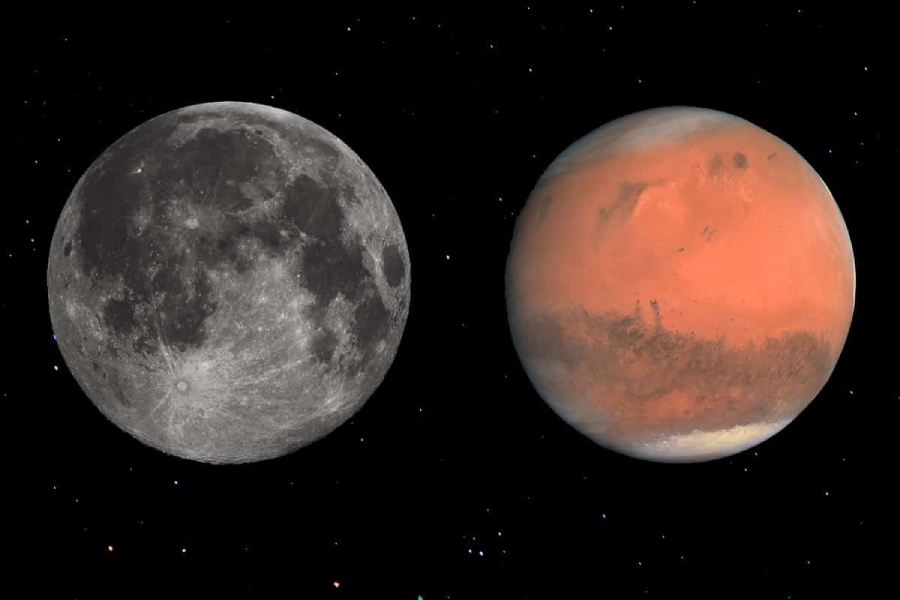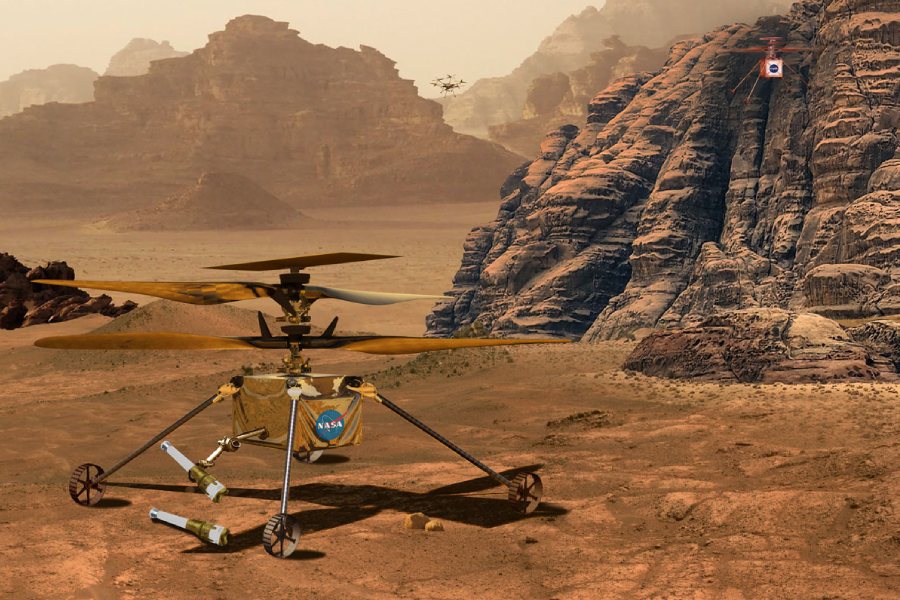Gazing up at the ruddy point of light that is Mars, it appears at first glance to have much in common with the grayish orb of Earth’s Moon. But how do our nearest celestial neighbors truly compare when analyzed side by side?
Do the Red Planet and our Moon share key traits and a similar nature despite their vastly different colors? What underlying attributes bind together or distinguish Mars and our Moon in the areas of physical geography, interior composition, surface features, origins, and evolution over time?
In this article, we analyze an in-depth comparison of Mars vs Moon. While the Moon’s familiar face has been known to humanity since prehistory, Mars has only unveiled its mysteries over the past century of study.
Read on to see what gives mighty Mars the competitive edge over the Moon in an exploratory contest of celestial proportions.

Mars vs Moon Major Differences
Mars and the Moon exhibit significant differences in terms of size, composition, atmosphere, geological features, and potential for human exploration.
Mars, the fourth planet from the Sun, is larger than the Moon and has a diverse surface with features such as canyons, volcanoes, and a prominent equatorial canyon system known as Valles Marineris. It has a thin atmosphere primarily composed of carbon dioxide.
The Moon, Earth’s natural satellite, is smaller than Mars and lacks a substantial atmosphere. Its surface is marked by impact craters, lunar seas (maria), and mountain ranges. The Moon’s gravity is much weaker than Mars.
Physical characteristics
Size, distance, and interior composition
How big is Mars compared to the Moon? Mars has about half the diameter of Earth at 4,212 miles across. The Moon is much smaller at 2,159 miles wide – making Mars over twice as large.
Mars orbits 142 million miles from the Sun. The Moon orbits Earth at an average distance of 238,855 miles away. So, the Moon resides much closer to Earth than Mars does.
Like the Moon, Mars features an iron core making up about a fifth of its volume, along with thick and thin crusts along with mantle rock. Differences may exist deeper down, possibly influencing their evolution.
Martian mountains, plains, and impact craters
Mars hosts immense volcanoes like Olympus Mons, over triple the height of Mount Everest at 16 miles high and 387 miles wide. Valles Marineris Canyon would stretch North America if placed on Earth. No equivalent landforms exist on the Moon.
Lunar craters and flat volcanic plains called maria or “seas” span the Moon’s terrain. By comparison, Mars exhibits varied geography from mountains to valleys to wide channel-laced plains showcasing immense past water and lava flows.
Both Mars and the Moon exhibit heavy cratering, with thousands dotting their landscapes – evidence of cosmic bombardment. Differences in erosion rates have softened Mars’ craters compared to stark lunar craters still crisp from lack of erosion. Mars also shows fewer older large basins indicating greater surface renewal.
Atmosphere and climate
Mars’ thin carbon dioxide shroud
Mars is wrapped in a wispy atmosphere composed of 95% carbon dioxide. It extends 74 miles up with pressure equal to Earth’s peaks. This thin shroud enables some weather formations like fog, clouds, and winds to sculpt surface dust and rock.
Temperatures exhibit similarities to Earth, with polar winters and equatorial summers. However, daily temperature swings may exceed 181°F due to the atmosphere’s limited insulating effect. Sudden, intense dust storms can erupt, fueled by blowing dust and ice particles.
Moon’s negligible exosphere and implications for exploration
Unlike Mars, the Moon lacks any tangible atmosphere for moderating climate or enabling weather. An ultra-thin exosphere of stray hydrogen and helium atoms constitutes lunar “air”. With no atmosphere to retain solar heat, surface temperatures swing wildly from 224°F in sunlit areas to -298°F during two-week nights.
The long days and nights also prevent weather development. Thin as it is, Mars’ atmosphere offers protection from small meteorites and radiation. It also means aerobraking of spacecraft is possible. Future colonies could perhaps use Martian air for needs.
The Moon provides no atmospheric shielding. However the permanency of lunar vacuums allows easier construction of airtight structures. It also eases rocket launches and landings.

Potential for human exploration
History of visiting Mars and the Moon
Multiple rovers and orbiters have revealed Mars’ secrets over decades, but no humans yet. Over a half-century ago, 12 astronauts walked on the lunar surface. This happened during six Apollo Moon landings from 1969-1972. No one has visited the Moon in person since 1972.
NASA plans future crewed flights for lunar exploration. Independent groups and SpaceX target near-term Mars missions. They are laying the groundwork for humanity’s multiplanetary expansion to both worlds and beyond.
Challenges for exploration
The Moon’s barren vacuum requires pressurized suits and habitats but enables easier mobility. Mars requires radiation and storm sheltering, too. This is due to its global dust storms and more intense cosmic radiation hitting its atmosphere-stripped surface.
Rocket fuel production may tap lunar polar ice reserves. Mars depends on scarce natural deposits and artificial in-situ manufacturing. This is for return trips to Earth, at least initially, until self-sufficient off-world bases expand.
Opportunities each location offers
The Moon provides a technical testing ground for Mars operations in some regards while offering struggle over long-term habitat independence. Relatively nearby lunar terrain may support asteroid mining, astronomy, and even tourism someday as well.
Red Planet exploration fulfills humanity’s quest to reach across once unimaginable gulfs. It allows us to walk an alien world brimming with history, even if it is harsh and remote.
Few sights match Martian vistas under dusty pink-tinted skies awaiting new pioneer footprints pressed into the endless frontier. Both worlds beckon across silent voids from above our faraway small blue marble, each premier stepping stone to the stars.
Potential for habitability
Possibility for life and prospects for colonization
As Mars’s orbit lies within the Sun’s habitable zone, evidence mounts for warm, wet ancient Martian environments. These environments could have been potentially conducive to basic life forms long ago. It’s uncertain whether or not life ever arose.
Perpetually frozen lunar regolith and environments leave no room for any organism ever to gain a foothold. Some maintain this is possible unless done artificially. Although devoid of life itself, Mars still presents frontiers where humanity could permanently expand.
It draws on stores of frozen groundwater, minerals for construction, and metals for infrastructure. Mars features subtly beautiful yet haunting expanses. These are still imprinted by lost hydrologic cycles now dormant.
The Moon, though lifeless, offers resources and a platform for exploration, development, and potential colonization. Its unique environment and strategic location make it a promising stepping stone for further space exploration.
This also makes Moon a testbed for innovative technologies. Despite lacking the potential for indigenous life, the Moon holds great promise for human utilization and expanding our presence beyond Earth.
Comparison of key habitability factors
Beyond distance, Mars boasts present-day stores of carbon, nitrogen, and minerals necessary for development. It also offers natural protection from solar and cosmic radiation provided by its atmosphere and soil. Access to frozen water also helps enormously in the long term.
The Moon requires importing virtually all materials for building construction. It also needs expensive, airtight sealing due to the inherent hazards of its airless environment. The initial settlement would be extremely challenging on the Moon.
However, once established, the low gravity could allow easier expansion in unique ways not viable on planets. The Moon’s weak gravitational pull makes launches far simpler compared to Earth. Both offer challenges that technology must overcome before flowing rivers or homemade atmospheres transform these new frontiers.
Still, they are achievable through dedication and planning, no matter the personal motivation. It requires sacrifice in exchange for a chance at an untrammeled room to grow beyond Earth’s bounds.
Technological Challenges and Solutions
The thin atmosphere of Mars poses significant challenges for landing spacecraft, requiring the use of parachutes and retrorockets to slow down landers. Advanced guidance and navigation systems are employed to enable precision targeting.
On the surface, rugged terrain hampers rover mobility, which is addressed through specialized vehicle designs and efficient, reliable systems that support months-long operations.
In contrast, the Moon’s lack of atmosphere results in extreme temperature swings, ranging from scorching 224°F days to frigid -298°F nights. To protect surface infrastructure and astronauts, insulated spacesuits and habitats equipped with redundant systems are essential.
Comparison of landing, transportation, and life support systems
Mars requires advanced entry, descent, and landing systems to handle its atmospheric density. The Moon’s lack of atmosphere makes this much simpler. Supplying breathable oxygen is also more challenging on Mars.
Power solutions differ – solar is more viable on the Moon due to its proximity to the Sun. Mars may require nuclear or resource-utilization systems. Mobility designs must be hardened for the Mars environment.
Life support and infrastructure for permanent settlements are simpler on the Moon by using fully enclosed habitats. But this is more complex on Mars even when using naturally occurring Martian resources like underground water ice for manufacturing.
Overall, establishing a presence on Mars poses greater technological difficulties.
Conclusion
Mars and the Moon share general similarities as small, airless worlds in our solar system. However, crucial differences clearly distinguish the Red Planet as a dynamic, changing Earth-like sphere far evolved beyond the frozen-in-time terrain of cratered Luna.
We hope analyzing Mars vs Moon head-to-head has illuminated unique properties. These include size, origins, geologic processes, physical makeup, and potential for past or present water. By understanding their asymmetric life cycles, we gain an appreciation of what drives planetary destiny across our cosmos.
Mars is considered a living world, while the Moon is seen as having a dead past. In the end, this match-up reminds us that one must deeply investigate other worlds by every scientific measure. We shouldn’t assume likeness based on a passing glance upward at casually similar disks shining overhead.
